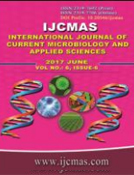


 National Academy of Agricultural Sciences (NAAS)
National Academy of Agricultural Sciences (NAAS)

|
PRINT ISSN : 2319-7692
Online ISSN : 2319-7706 Issues : 12 per year Publisher : Excellent Publishers Email : editorijcmas@gmail.com / submit@ijcmas.com Editor-in-chief: Dr.M.Prakash Index Copernicus ICV 2018: 95.39 NAAS RATING 2020: 5.38 |
Labeo rohita, popularly known as rohu is a widely cultured species in the whole Indian subcontinent. Knowledge of the genetic diversity of this species is important to support management and conservation programs which will subsequently help in sustainable production of this species. DNA markers, mostly microsatellite markers are excellent tool to evaluate genetic variation of populations. The present study deals with genetic diversity analysis of Labeo rohita collected from hatchery and Dhaura reservoir of Uttarakhand through microsatellite marker. Total 20 microsatellite primers were designed by using software Primer-BLAST and Primer-3. A total of 12 microsatellite loci were successfully amplified. After performing native PAGE using amplified 50 DNA samples each, POP GENE Version 1.32 was used to calculate microsatellite variation. The average expected Nei’s genetic diversity ranged from 0.328 to 0.529 with mean value of 0.458 for Labeo rohita across all loci from hatchery whereas the average expected gene diversity ranged from 0.328 to 0.529 with mean value of 0.458 for Labeo rohita across all loci from Dhaura reservoir. The observed and expected heterozygosity ranged from 0.2237 to 0.3326 and 0.2786 to 0.3763 respectively for Labeo rohita from hatchery. The mean value of observed heterozygosity was 0.2864 and that of expected heterozygosity was 0.3238. Mean Fis values were found to be 0.193 at all loci in hatchery and 0.169 at all loci in Dhaura reservoir. The observed and expected heterozygosity ranged from 0.4010 to 0.4612 and 0.4217 to 0.4985 respectively for Labeo rohita from Dhaura reservoir with mean value of observed heterozygosity was 0.4226 and expected heterozygosity was 0.4716. Mean values for Shannon’s information index for all microsatellite loci were 1.1091 for hatchery and 1.1545 for Dhaura reservoir population. Genetic diversity analyses revealed substantial changes in genetic variation and significant genetic differentiation between the wild and hatchery-produced populations of L. rohita. These results indicate that genetic drift may have negative effects on the reproductive capacity of the stock, because genetic factors are important in the production of high quality seed. A wide geographical location, different hydro-biological conditions, different habitat and no connectivity between these two water resources and low or absence of gene flow between the populations may be the possible reasons to make reservoir and hatchery populations differentiated.
 |
 |
 |
 |
 |